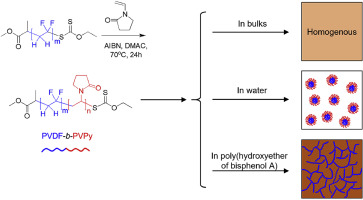Polymer ( IF 4.1 ) Pub Date : 2018-03-13 , DOI: 10.1016/j.polymer.2018.03.025 Lei Li , Jingang Li , Sixun Zheng

|
In this contribution, we reported the synthesis of poly(vinylidene fluoride)-block-poly(N-vinylpyrrolidone) (PVDF-b-PVPy) diblock copolymers via a sequential reversible addition-fragmentation chain transfer / macromolecular design via the interchange of xanthate (RAFT/MADIX) approach. First, the radical polymerization of vinylidene fluoride (VDF) was carried out with O-ethyl-S-(1-methoxycarbonyl)ethyldithiocarbonate as the starting chain transfer agent and a xanthate-terminated PVDF was obtained. The xanthate-terminated PVDF was then used as the macromolecular chain transfer agent further to mediate the radical polymerization of N-vinylpyrrolidone (NVP) and the PVDF-b-PVPy diblock copolymers were successfully synthesized. The kinetics of NVP polymerization was investigated by means of gel permeation chromatography (GPC). By controlling the molar ratios of the macromolecular chain transfer agent to NVP, a series of PVDF-b-PVPy diblock copolymers with variable lengths of PVPy were obtained. The PVDF-b-PVPy diblock copolymers displayed the interesting self-assembly behavior. It was found that for the PVDF-b-PVPy diblock copolymers no self-assembly behavior was exhibited in bulks. Nonetheless, the diblock copolymers were capable of self-assembling into the nanoobjects in aqueous solutions. In addition, the diblock copolymers displayed composition-dependent microphase-separated morphologies in their blends with poly(hydroxyether of bisphenol A). The different self-assembly behaviors have been interpreted in terms of differential scanning calorimetry (DSC), transmission electron microscopy (TEM) and atomic force microscopy (AFM).
中文翻译:

聚(偏氟乙烯) -嵌段-聚(Ñ乙烯基吡咯烷酮)二嵌段共聚物:合成通过顺序RAFT / MADIX聚合和自组装行为
-在此贡献中,我们报道聚(偏氟乙烯)的合成块-聚(Ñ乙烯基吡咯烷酮)(PVDF- b -PVPy)二嵌段共聚物通过顺序可逆加成-断裂链转移/大分子设计通过黄原酸酯交换( RAFT / MADIX)方法。首先,以O-乙基-S-(1-甲氧基羰基)乙基二硫代碳酸酯作为起始链转移剂进行偏二氟乙烯(VDF)的自由基聚合,得到黄原酸酯封端的PVDF。然后将以黄药封端的PVDF用作大分子链转移剂,进一步介导N的自由基聚合。-乙烯基吡咯烷酮(NVP)和PVDF- b -PVPy双嵌段共聚物已成功合成。通过凝胶渗透色谱法(GPC)研究了NVP聚合的动力学。通过控制大分子链转移剂与NVP的摩尔比,获得了一系列具有可变长度的PVPy的PVDF- b- PVPy二嵌段共聚物。PVDF- b- PVPy二嵌段共聚物表现出有趣的自组装行为。发现对于PVDF- b-PVPy二嵌段共聚物在本体中没有表现出自组装行为。尽管如此,二嵌段共聚物能够在水溶液中自组装成纳米物体。另外,二嵌段共聚物在其与双酚A的聚(羟基醚)的共混物中显示出组成依赖的微相分离的形态。不同的自组装行为已通过差示扫描量热法(DSC),透射电子显微镜(TEM)和原子力显微镜(AFM)进行了解释。









































 京公网安备 11010802027423号
京公网安备 11010802027423号